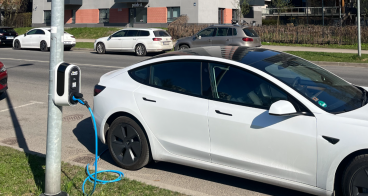Electric mobility transition project in the Arab Region
Electric mobility has the potential to contribute significantly to sustainable development in the Arab region. However, despite the incentives and subsidies (tax exemptions, purchase incentives, and charging infrastructure subsidies) put in place by different countries (e.g. Saudi Arabia, Jordan, Egypt, Tunisia, and many others), the adoption of electric vehicles (EVs) is still limited compared to other markets like Europe and China.
EV adoption in the Arab region faces challenges. Social acceptance is a prominent issue due to negative perceptions and low purchase intentions among citizens. Addressing the obstacles that prevent citizens from embracing electric technology is essential to accelerate the transition process.
What are the key barriers?
- First purchase cost: the cost of transitioning to new electric technology is proving to be a significant challenge. Despite the government’s efforts to incentivise the purchase of EVs through tax exemptions, subsidies, and bonuses it seems that more needs to be done to promote their adoption. The Total cost of ownership (TCO) can play a critical role in consumer decisions. Additionally, retrofitting is a potential solution for those who are hesitant to buy a new EV.
- Infrastructure: the lack of a reliable and accessible charging infrastructure is a concern for citizens. This anxiety, known as ‘range anxiety’, reflects the fear that the vehicle will not have enough battery charge to make it to its destination. This fear is compounded by the fact that suitable charging infrastructure, especially fast and ultra-fast charging, can be hard to find.
- Battery recharge time: many potential EV buyers are concerned about the time it takes for the battery to recharge, leading to what is known as ‘charge anxiety’. Without a reliable and accessible charging infrastructure, many people are discouraged from owning EVs. A dependable charging network is crucial to encourage more people to consider EV ownership.
- EV models: the limited availability of EV models and slow market penetration are also key barriers to EV adoption. These factors can affect the original purchase price and limit competition in the market. However, as more consumers begin to consider the benefits of EVs, we may see a shift towards increased competition and a wider range of affordable options.
Current situation: a closer look!
Incentives:
For example, the Tunisian government has introduced several measures to encourage electric and hybrid vehicle use, including a reduced customs duty on charging equipment, custom duty exemptions for pure electric vehicles, a 50% customs duty reduction for hybrid vehicles, and a bonus of 10,000 TND (around 2.980 EUR) per car from 2023 to 2025. Some areas in the country offer free charging stations currently. In Egypt, there is a subsidy of up to 50,000 EGP (around 1.900 EUR) on the purchase of locally manufactured EVs, exemptions from Tax registration fees, and value-added tax. In the United Arab Emirates (UAE), there is a 50% exemption from registration and licensing fees, as well as free charging and parking in some areas. In Oman, there is no VAT, customs tax, and registration fees, and in Jordan, there is an exemption in customs duties and sales tax and a reduction in private EV charging costs.
EV adoption:
According to recent data, the UAE currently has a sales penetration rate of 3% for EVs. Egypt is also showing promising growth in this area, with up to 4,000 EVs currently on the roads and an expected rise by 2025. However, in Jordan, there has been a significant increase in the number of EVs on the roads, with up to 60,000 vehicles. Moreover, Tunisia aims to increase its EVs from 50 to 5,000 by 2025 with the "Increasing the adoption of electric mobility in Tunisia" project launched by the Environment Ministry, the National Agency of Energy Management (ANME), and the United Nations Industrial Development Organization (UNIDO).
Charging infrastructure deployment:
Several countries have launched initiatives to promote the development of charging stations such as Saudi Arabia, Jordan, UAE, Tunisia, and others. Take for example, Dubai's initiative to increase their current 370 charging stations to over 680 by 2025, with the ultimate goal of establishing 1,000 stations. Saudi Arabia already has over 100 public charging stations (2,803 charging points, with most of them installed at corporate and residential places), while Jordan has set an ambitious target of installing 50,000 public and private chargers by 2025. Tunisia is also dedicated to the cause, aiming to install an additional 500 public charging stations by 2025. Morocco is on track to establish an impressive 2,500 EV chargers by 2025, with Qatar aiming to set up 2,200 to 2,400 DC charging stations by the same year.
Manufacturing investment:
Examples such as Egypt and China teaming up to produce affordable EVs, Lebanon's initiative to manufacture 10,000 EVs, and Saudi Arabia's focus on industry localisation with LUCID Motors and CEER, indicate the growing interest in electric mobility in the region. Furthermore, Morocco and Tunisia have made strides in developing hydrogen fuel cells and three-wheeled solar-powered EVs. Morocco's recent agreement with Gotion High Tech to set up an EV battery factory with a potential investment of up to $6.3 billion underscores the region's commitment to promoting sustainable and eco-friendly practices.
EV brands:
Diverse EV brand preferences exist across countries. In Qatar, Toyota, Nissan, Mitsubishi, and Honda dominate the market. In the UAE, popular options include Nissan, Renault, Chevrolet, and Tesla. Saudi Arabia displays a preference for Tesla, BMW, Nissan, and Hyundai, while BMW, Mercedes, Tesla, and Volkswagen seem to be the top picks in Egypt. In Jordan, a variety of electric vehicles from Volkswagen, Toyota, Hyundai, Chevrolet, and Ford can be seen on the streets.
Perspectives and growth targets by 2030
It is interesting to look at the projections for the EV market share in the region for 2030. Based on current commitments and estimates, Oman is expected to reach 10% of EV sales and 15000 EV chargers by 2030, while Saudi Arabia is projected to grow 10-25% in EV sales. In Dubai, the goal is for 30% of public sector vehicles and 10% of all vehicle sales to be electric and hybrid by 2030. Tunisia has set a target of having 130,000 EVs on their roads by 2030, and other countries are also following suit.
In summary, the potential for electric mobility to drive sustainable development in the Arab region is undeniable. Governments across the region have introduced a range of incentives and initiatives to promote the adoption of electric vehicles (EVs). Despite this progress, certain challenges, including social acceptance, infrastructure limitations, and concerns about cost and charging times, persist.
However, there is reason for optimism. The data indicates that several Arab countries are making significant strides in increasing the adoption of EVs, expanding their charging infrastructure, and even exploring manufacturing opportunities. With concerted efforts, it is possible to overcome these barriers and accelerate the transition to electric mobility.
Dr. Marwa Ben Ali: has a PhD in electrical engineering and is currently a postdoctoral researcher at Unibz (Italy). Her research mainly focuses on electric mobility, optimisation, management, and analysis.
Find out more about the Urban Mobility Consultancy here.
Published on 14 November, 2023






